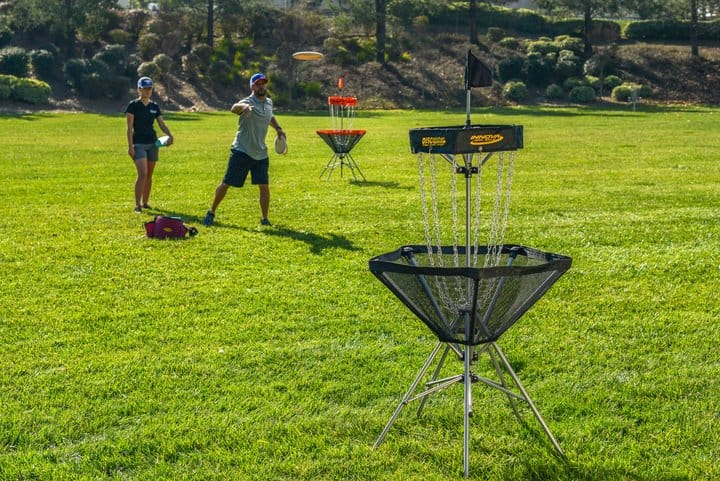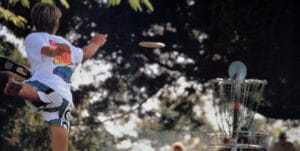The Secrets to Effective Putting Practice
Table of Contents
In our “Taking Flight” series on the DGU Blog, we will be focusing on tips that can help you improve your game. These concepts should make a difference, whether you are a beginner just getting into disc golf or you are looking to better your skills at any level.
In this post, we want to focus on putting practice. Yes, Allen Iverson, we’re talking about practice!
There’s an old golf saying that goes “Drive for show. Putt for dough.” It definitely applies to disc golf, as well. The more consistent you can be with your putting, the better player you will be. Just watch the professional players. They may be wild on some drives. Not every upshot is perfect. They may take OB strokes. However, they can just about every putt inside circle 1, along with a relatively high percentage in circle 2 and beyond. Putting may look easy for the pros, but it’s because most of them practice putting more than anything else.
Here are 7 helpful putting practice tips you can apply:
1. Make Time for Practice Before Your Round
Make an effort to get to the course early and take some time on the practice basket. If you roll up and head right to the first tee, it may take you a few holes to find your putting rhythm. A little time practicing and getting a feel for your putts can make a huge difference out on the course.
2. Focus on Shorter Putts
We see too many players camp out at circle’s edge and just practice from there because “that’s where they need the most work.” Then, they get out on the course in a tournament and are left with one “tester” putt after another in the 15-25 foot range. These are the putts you have to master if you are going to become a better player. You can practice longer putts. Just make sure your shorter putts are dialed in so you have full confidence when it counts.
3. Develop Your Own Routine
Every player is different and every player should have his or her own putting practice routine that works for them. Some like to stay in one spot and work on building muscle memory by throwing the same putt over and over. Others like to move around to different distances, wind angles and elevation changes to simulate actual on-course situations. There is no wrong approach here as long as you find a routine that helps you get mentally and physically ready for your round.
4. Rapid Fire vs. Slowing it Down
On the heels of the tip above, this is one where you might get different opinions depending on who you talk to. Some players believe in more of a rapid-fire technique with 5-10 putters in hand and one fairly quick putt after another. The idea here is all about muscle memory. In this approach, it’s still a good idea to slow down a little and make sure you still use your normal form with a consistent stance, load and release. You still want to emulate your normal putting motion as much as you can, even if you are going a little quicker than you would on course. Conversely, some players will argue they get better results by slowing it down and trying to grind out every practice putt as if every putt was the real deal. This means maybe only using one or two putters and going through your entire pre-shot routine each time. The benefit of this approach is to keep your practice consistent with your actual play. Ultimately, it’s up to you which approach—or combination of approaches—provides the best results on the course. We recommend trying both and seeing what works!
5. Use the Same Putters
Look in any professional player’s tournament-day bag and you will typically see 2-3 identical putters that are equally beat-in. Look at their practice bag/basket and you may see even more of the same discs. If your primary putter is a KC Pro Aviar, stockpile a few that are around the same weight (maybe even the same color). Not only will this give you backups in case you lose your primary putter or decide to retire it, but it should also benefit you from a practice standpoint. Using the same putter molds, plastics and weights will help you dial in a consistent form. An R-Pro Rhyno, for example, will fly a bit differently than an Aviar, and of course there are numerous different types of Aviars in Innova’s lineup, as well. If your practice basket has a hodge podge of random putters, you may not see consistent results.
6. Get a Practice Basket

Once you are hooked on the game of disc golf, getting a practice basket for your home almost becomes a rite of passage. It’s something we all want to have. You don’t have to go out and get a professional course-grade Discatcher target. That would be nice, but probably not as practical. Innova and Discmania make all sorts of different baskets to suit your budget and your practice needs. You may consider an affordable Discatcher Traveler or Skillshot Target that you can easily pack up and take with you anywhere you go. Or, you may want something sturdier and semi-permanent if setting up in your backyard.
7. Use Your Practice Basket
Last but not least, you’ll want to actually use your practice basket and develop your own home putting routines. Getting a nice practice target is great, but it really won’t help your game unless you utilize it. It’s a great way to develop a consistent form while improving your mental focus when standing over those pressure putts in a tournament round.
They say practice makes perfect, but ultimately it’s up to you how you want to practice and how much you want to practice your disc golf putting. We can almost guarantee the more effort you put in, the easier it will be to putt out when it matters most.
What's Next?
Need help finding the perfect disc for a specific shot, better accuracy, or more distance? We’re here to help! Just follow the link below to answer a short questionnaire. We’ll send you FREE personalized disc recommendations within 1 business day along with a coupon code for $5 off your next order.
GET PRO TIPS


